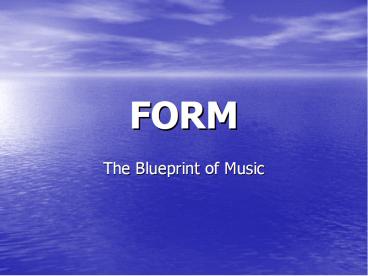FORM PowerPoint PPT Presentation
1 / 16
Title: FORM
1
FORM
- The Blueprint of Music
2
Why do we have form?
- Form is a way to organize music in a way that
makes more sense to the performer and the
listener. - Form is a key part in helping with communicating
music.
3
Types of Forms in Music
- There are many different types of forms in music
some range from relatively simple to incredibly
complex. - The forms we will discuss are binary (AB),
ternary (ABA), canon, round, theme and variation,
fugue, rondo, and sonata allegro. - Overall structures (larger forms) include
symphony, concerto, sonata, and suite.
4
Binary Form (AB)
- Binary Form or AB form is the MOST used form in
all pop, rock, country, and some rap music. - Prefix bi- means TWO so Binary Form is any song
that has two main parts. - Music on the radio is mostly binary because those
two parts are - verse and chorus
5
Ternary Form (ABA)
- Ternary Form or ABA form is a form that has 3
distinct parts. - The A section returns at the end in its
entirety to form the ABA - Think of it like a sandwich with the first slice
of bread being A, meat/cheese being B and the
bread returns again with A.
6
Canon/Round
- A canon and round are essentially the same thing.
- To perform a canon/round, one group of musicians
will begin playing at the beginning of a piece
and once they reach a certain spot, another group
begins at the beginning. - Ex. Row Row Row Your Boat
7
Theme and Variation
- Theme and variation is one of the easiest forms
to recognize when you hear it. - First, a theme is played then as the piece
progresses, that same theme continues to be
played, but the composer changes it slightly
(perhaps adding more notes, taking away notes,
changing harmonies) to create variations. - Each variation of that theme is usually separated
into a section all its own (meaning there are
usually moments of silence between each
variation).
8
Fugue
- The fugue is one of the more complex forms in
music, but they can also be relatively simple. - In a fugue, there is a main theme/melody called a
subject. A fugue begins with just ONE voice
playing or singing that subject. - The one voice plays all the way through the
subject and once it is finished, another voice
enters playing the subject again while the
original voice plays harmonic material. - Once that second voice finishes the subject,
another voice enters at the beginning of the
subject. - The piece continues on with different voices
trading around the subject until it finally ends
with one last statement of the subject.
9
Rondo
- Rondo form is quite simply a form where a section
keeps coming back. - A common layout for rondo form is ABACA the A
section is stated at the beginning then comes
back two more times exactly the same as before.
The two middle sections (B and C) are not
only different from A, but also different from
each other.
10
Sonata Allegro Form
- Sonata allegro form is a more in-depth version of
Ternary Form (ABA) - Sonata allegro form has 3 main sections (ABA) but
each of those sections has a specific name. - The first A (A1) is called the exposition
- B is called the development
- Second A (A2) is called the recapitulation
- Each section has a specific purpose/job
11
Sonata Allegro Form Cont
- The Exposition states the two main themes of the
piece of music. - The Development takes those two themes and
(similar to the variations from theme and
variations) changes them to create new material
that sounds different but recognizable at the
same time. - The Recapitulation restates the two main themes
from the Exposition almost exactly the same way
they were heard before in the exposition.
12
Sonata Allegro Form contd.
- Sonata allegro form is the most used and
frequently seen form in classical music. - It is used as parts of symphonies, concertos,
sonatas, and on its own as well. - Composers such as Mozart and Haydn made this form
very popular and later Beethoven revolutionized
the form making it his own.
13
Larger Forms
- Symphony a large orchestral work usually made
up of 4 movements. - 1st Movement is Fast and usually in sonata
allegro form. - 2nd Movement is slow/lyrical
- 3rd Movement is dance-like
- 4th Movement is either very fast and brilliant or
very dramatic and heroic. - Symphonies are one of the major forms used by
composers most classical composers composed at
least ONE symphony some composers such as Haydn
wrote over 100 in their lifetime.
14
Concerto
- A concerto is a specific form written for a solo
instrument with an orchestra accompanying. - The concerto has 3 movements usually following a
format of Fast, Slow, Fast. - The first movement of a concerto is also normally
in sonata allegro form.
15
Sonata
- A sonata (not sonata allegro form) is a piece
of music written for a solo instrument to play by
itself (with no one else except maybe a piano). - A sonata has 3 movements just like a concerto
usually following the format of Fast, Slow, Fast.
- The first movement of a sonata (just like a
concerto and symphony) usually uses the sonata
allegro form.
16
Suite
- A suite is usually a collection of 5 short pieces
(usually dances). - They vary in tempo from movement to movement but
usually start Fast and end Fast.

